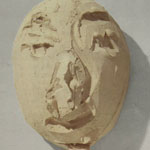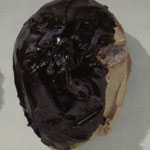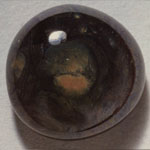1984 Calendar
To Live in this Turmoil of Life and Death
Yuhuizi Wang, Bryn Mawr College, Class of 2016
The act of war and the devastating results have always been popular subjects for artists all over the world. Those artworks prevent the memories of war from fading away, and serve as forever warnings of the man-made madness. Such is in this case, too. Kita Kazuaki's works are deeply appreciated because of the vivid narration of disaster and depiction of humanism.
The calendar of Kita's ceramic works was donated by Milton Lowenthal, who sponsored Kita Kazuaki's art, to Swarthmore College. This page features a work titled "Nuclear Destruction in a Flash," a six-part series of ceramics made of clay mixed with soil from Hiroshima and Poland's Auschwitz, which produced to memorialize the victims of the atomic bombings. From left to right, Kita represents the destruction of a human being, burnt into ashes by the atomic bomb. The deformity of the human figure vividly conveys to the audience the horror and fatal destruction of atomic bombings. As Barry Till, the curator at The Art Gallery of Great Victoria, writes in Quest for World Peace: Ceramics by Kazuaki Kita, "In this work, Kita has captured the essence of death from an atomic bomb, whose flaming inferno can cause a terrified scream to become totally silent" (1985, p9). The reduction in size across the six parts visually presents the transformation from tragic chaos to ultimate silence. Furthermore, it can lead the audience to a silent dialogue with the artwork, praying for the innocent souls and resolving for peace. Specifically speaking, the first part is a face-like sculpture easily identified as a representation of a human being from the contoured facial features (Figure 2). Instead of using the potter's wheel, Kita forms all shapes and dimensions by hand. As a result, the figure may not appear realistic, but Kita's spontaneous and free lines mark a human trait in his works. The second part is a typical "Death Mask" which Kita is famous for(Figure 3). The idea is possibly inspired by Japanese tradition using masks in "Noh" drama as an art form to express human emotions. Each mask often embodies one particular facial expression. However, Kita's "Death Mask" varies according to changes in lighting conditions. When the lights strike the mask differently, the audience perceives different images. Some claim the "Death Mask" reminds them of Demons, while argue that they see similarities with Christ on the cross.
However, along with effects of destruction, Kita also adds hopeful wishes in his work by concluding the series with a round shape that represents peace and unity(Figure 4). The so-called "Tohen Temmoku glaze" shown in the sixth piece implies the spirit and dignity of the "hibakusha" (atomic bombs victims). "Tohen Temmoku glaze" is one of the most mysterious secrets of ceramics. Only seven examples of Yohen ceramics have survived today. After years of dedication to his career, Kita successfully rediscovered and perfected the technique of making Tohen Temmoku glaze. The technique of Tohen pottery is to create different shades and colors of ceramic using different angles of lights. Very often, it is interpreted as an attempt to replicate the shine of jewels. By applying such technique in his ceramic works, Kita highlights the preciousness of humanity. The glaze has become a signature of Kita's ceramic works, especially his ceramic vessels. As Till states in his book, "While Kita's death masks convey a powerful warning of nuclear annihilation, his ceramic vessels speak equally eloquently of peace and harmony. Thus Kita's art offers us two alternatives - either horrific agony or exquisite ecstasy. Through his art, he seems to ask, ‘Which path do you prefer?"(Till, 1985, p10). Kita seems to provide all the possibilities for us to explore and interpret his work in "Nuclear destruction in a flash."
For the death masks in this work, Kita used clay mixed with soil from Hiroshima and Poland's Auschwitz. Cohesively they symbolize the great tragedies of World War II. Furthermore, as Till notes, "In these masks, which have been fired with a iridescent glaze at over 1,200 degrees Celsius, one can almost feel the agony of the victims whose flesh melted instantly in the intense heat of the atomic bomb. When the lights hits the masks in certain ways, the nature of the glaze makes it seem as though the faces are still on fire and melting before our eyes" (1985, p8). The atomic bombing created similar high-temperature environment as the heating of ceramics. In another word, the heating process recreates the devastating destruction of the bombing, and conveys the victims' anger towards and denunciation of nuclear weapon use. No other media can be more appropriate than ceramic to address this topic. As discussed in the previous paragraphs, the final beautiful glaze of the ceramics implies the victim's spirit. One can also interpret the process and outcome as resilience of human nature after rigorous torture. Without the adversity caused by fire, as for the ceramics, or the war, as for human beings, the essential beauty can never be revealed.
The atomic bomb wiped out everything in the area, making it difficult to find images of the aftermath. Even artistic reproductions based on survivors' accounts, such as Barefoot Gen (1983), is too terrifying to look at. "Nuclear Destruction in a Flash" is important because it allows viewers to confront something they couldn't bear to look at in reality, while demanding a consideration of war and peace.




